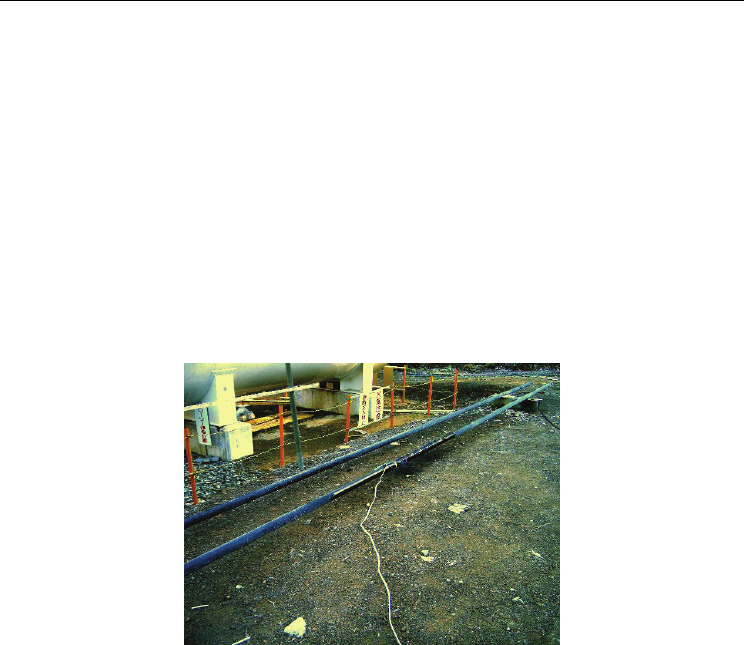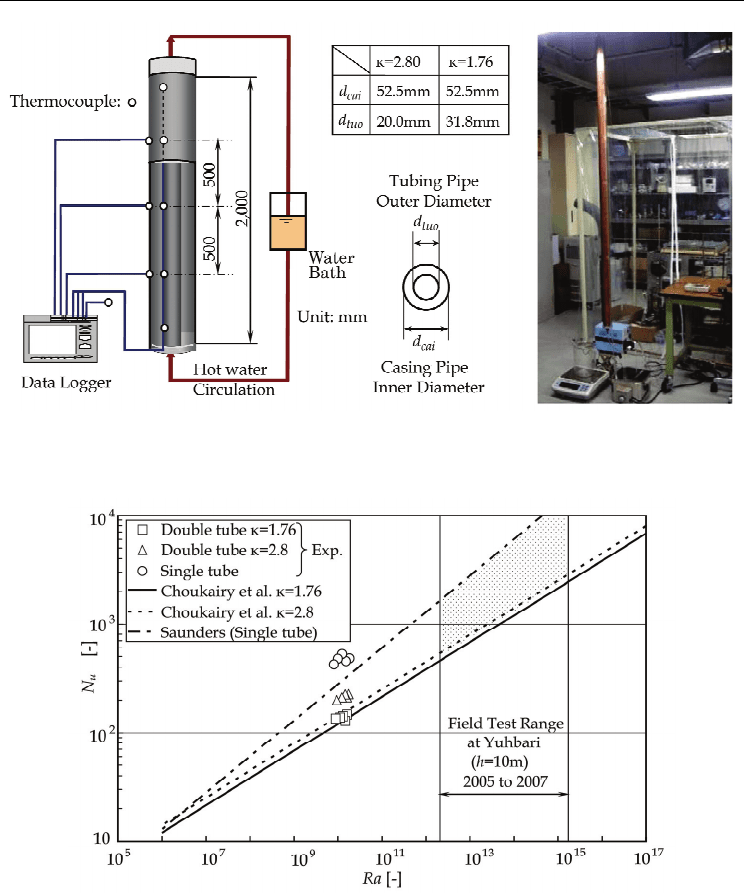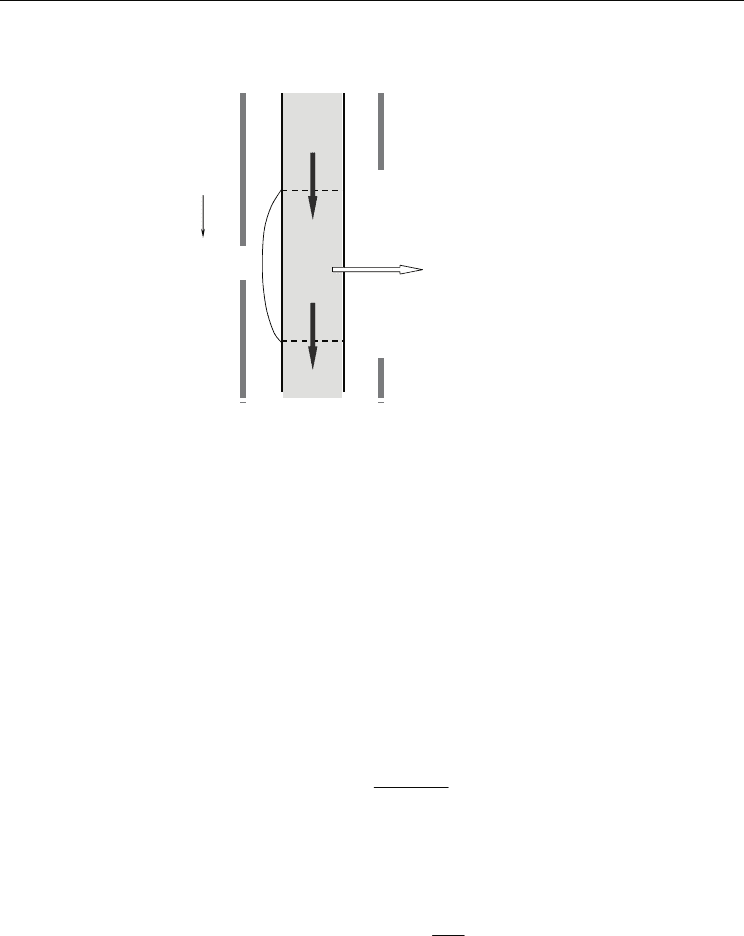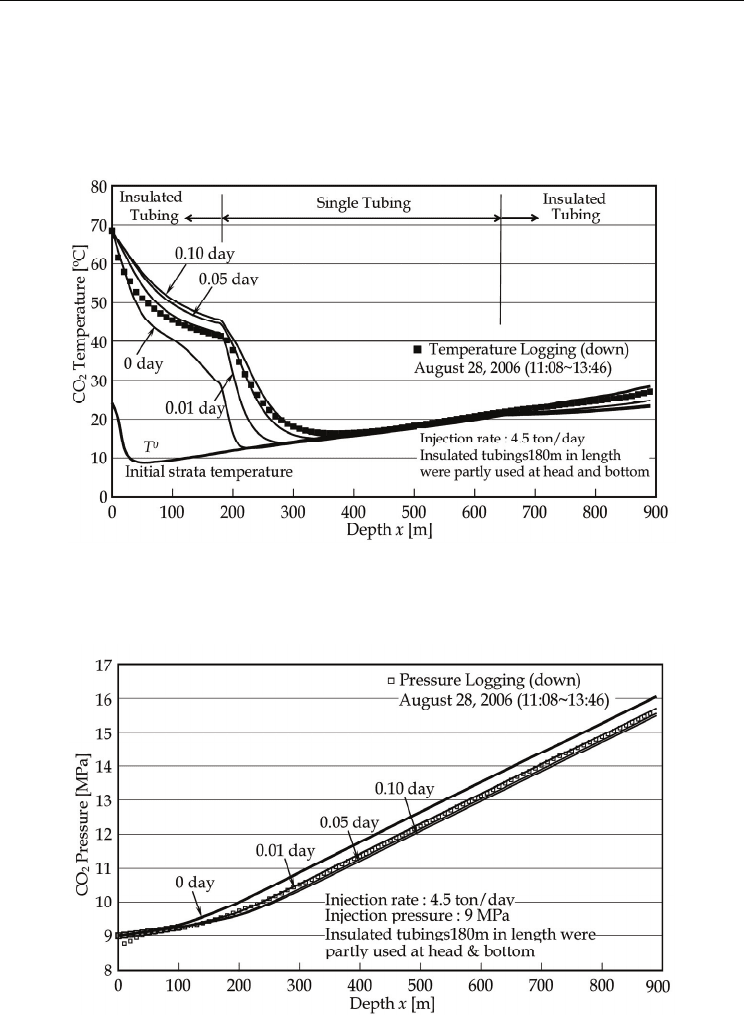Ahsan A. Two Phase Flow, Phase Change and Numerical Modeling
Подождите немного. Документ загружается.


Heat Transfer and Phase Change in Deep CO
2
Injector for CO
2
Geological Storage
569
where α
thi
is the heat transfer coefficient at the inner wall of the tubing pipe, λ
f
is the heat
conductivity of the fluid (water) in the annulus, λ
Steal
is the heat conductivity of the casing
and tubing pipes, N
u
is the Nusselt number for the annulus and n is a correction number to
adjust the heat conductivity of the argon gas layer in the insulated tubing.
2.5 Evaluation of performance of thermal insulated tubing
Thermal insulated tubing pipe is sometime used for geo-thermal wells through cold
formation in order to prevent heat loss from produced hot spring water/steam. In case of
the Yubari injected CO
2
-ECBMR test, connected thermal insulated tubing pipes 20 m in
length were used partially in 2005-2006 and totally in 2007. The insulated tubing includes
argon gas shield layer is enclosed between inner and outer pipes to prevent heat loss from
inside ideally with low thermal conductivity of argon gas; 0.116 W/m°C. However, joints
between pipes are not shielded, and natural gas convection flow in the shield is expected to
make increase the heat loss trasfered from the flow to outer tubing.
Fig. 4. Test to evaluate of equivalent thermal conductivity in the thermal insulated tubing
using by pulsed heating carried at Yubari CO
2
-ECBMR test field (Oct. 10, 2006) (see
Yasunami et al., 2010)
To evaluate the thermal performance of the insulated tubing, tests using a insulated tubing
pipe were carried out by pulsed heating from inside and measurements of outer and inner
surface temperatures of the pipe placed horizontally as shown Fig. 4. Furthermore, the
equivalent thermal conductivity was analyzed with Choukairy et al.’s equation (see section
2.5) and the history matching study for the well logging data. The thermal conductivity
correction factor for conductivity of argon gas, n, is evaluated as shown in Fig. 5.
The equivalent heat conductivity including inside convective heat transfer was evaluated as
three times larger as that of original argon gas without longitudinal heat loss through to
connected tubing pipes. The correction factor, n, was introduced to adjust the equivalent
heat conductivity of the tubing based on the original heat conductivity of argon gas. It was
determined to be n = 3 but heat loss through the joints that are between the insulated tubing
was not included in the test. The thermal equivalent conductivity of the insulated tubing
was determined to be n = 4 or λ = 0.21W/m°C based on the well logging temperature at the
Yubari CO
2
-ECBMR test site and the measurement data were obtained from the heater
response test carried out in the test field.

Two Phase Flow, Phase Change and Numerical Modeling
570
Fig. 5. Thermal conductivity correction factor for shielding with argon gas (*; spec value
provided by a steel pipe maker)
2.6 Convective heat transfer in the annulus
Natural convection of annulus fluids makes influences on the heat transfer rate from the
tubing pipe to the surrounding casing pipe and the formation. Choukairy et al. (2004)
presented the following formula for the Nusselt number, N
u
, for natural convection flow in
an annulus with various radius ratios:
1/4 5/4
()
f
uram
f
L
NPRT
mA
α
κ
λ
== ⋅ (6)
where
f
α
denotes the natural convection heat transfer coefficient on the inner surface of the
casing, L (=r
cai
- r
tuo
) is the width of the annulus, κ is the radius ratio, m is a constant defined
by Choukairy et al., A is the aspect ratio, P
r
is the Prandtl number, R
a
is the Rayleigh number
and T
m
is a dimensionless temperature defined by following equations:
h
A
L
=
(7)
cai
tuo
r
r
κ
= (8)
3
()
f
w
Tc
a
ff
gT T h
R
β
αυ
−⋅
=
⋅
(9)
4/5
1
1
m
T
κ
=
−
(10)
where h
c
is the circulation height of natural convection flow, g is the acceleration of gravity,
β
T
is the coefficient of thermal expansion of the fluid, υ
f
is the dynamic viscosity and
f
α
is
heat diffusivity of fluid in the annulus. The Nusselt number, N
u
, calculated by Eq.(4) was
used for each elevation.

Heat Transfer and Phase Change in Deep CO
2
Injector for CO
2
Geological Storage
571
Fig. 6. Experimental setup to verify natural convection heat transfer coefficient in the
annulus (Yasunami et al., 2010)
Fig. 7. Experimental results of Nusselt number for convective heat transfer in annulus
(Yasunami et al., 2010)
Laboratory experiments were carried out to verify the reliability of Choukairy’s equation
and to investigate the heat transfer rate using the well models consisting of two copper
pipes with different diameters as shown in Fig. 6. Hot water at 40 to 60 °C was circulated
through the inner pipe instead of CO
2
. Pipe temperatures were measured by T-
thermocouples that were placed on the pipe surfaces. Figure 7 shows experimental results

Two Phase Flow, Phase Change and Numerical Modeling
572
obtained for N
u
and compared with those from Choukairy’s equation. In addition, measured
values of N
u
on the outer surface of the single tubing determined using the equation
proposed by Saunders [after Rohsenow et al. (1998)] were also compared in Fig. 7. Based on
these results, we have found that Choukairy’s equation is able to evaluate the heat transfer
rate in the annulus.
2.7 Unsteady casing temperature
On the other hand, the temperature of the formation outside the casing pipe (outer surface)
increases gradually after the injection. Assume T
0
is the initial strata formation temperature
and T
an
is the temperature in the annulus, the temperature at outer surface of the casing T
w
,
can be given by the solution for the unsteady heat conduction equation; Eq. (3). It has been
presented by Starfield and Bleloch (1983):
0
()
wan an
t
ti
TT TT
B
η
η
=+ −
+
(11)
where η
t
is defined as the elapsed time factor and B
i
is the non-dimensional Biot number,
and B
i
is defined by following equation:
ca cao
i
r
r
B
α
λ
⋅
= (12)
where
ca
α
is the apparent heat transfer rate at the inner casing and λ
r
is the heat
conductivity of rock. Starfield and Bleloch (1983) reported equations for the elapsed time
factor η
t
, which is a function of the Fourier number, τ, and Sasaki & Dindiwe (2002)
revised
it for τ≤1.5 as:
2
1
1.5
[0.9879 0.3281(ln ) 0.03064(ln )
t
τη
ττ
≤=
++
(13)
1
1.5 10
[0.979813 0.383760(ln )
t
τη
τ
≤≤ =
+
(14)
1
10 100
[0.839337 0.444718(ln )
t
τη
τ
≤≤ =
+
(15)
23
2(1 )
1000
0.57722
t
τη
Λ−Λ−Λ−Λ
≤=
(16)
0.57722
[ln(4 ) 1.15444)
τ
Λ=
−
(17)
2
r
cao
t
r
α
τ
= (18)
The elapsed time factor η
t
vs. Fourier number
τ
calculated by equations (13) to (18), is
presented in Fig. 8.

Heat Transfer and Phase Change in Deep CO
2
Injector for CO
2
Geological Storage
573
Fig. 8. Elapsed time factor vs. Fourier number
Fig. 9. CO
2
pressure-specific enthalpy and phase diagram calculated with PROPATH(2008)
for 10 to 100 °C and 1 to 100 MPa (○; Critical point; 31.1°C and 7.38MPa)
2.8 Numerical equations for the determination of the CO
2
specific enthalpy
Changes in CO
2
temperature and phase (gas, liquid and supercritical) are accompanied by a
specific enthalpy change. CO
2
specific enthalpy, E(P,T) may be expressed by:
00
(,) (1 )
TP
f
pi
TP
E P T C dT V T dP
β
=+−
(19)
where V is the specific volume, β is the coefficient of thermal expansion, T
0
and P
0
are triple
point temperature (=-56.57°C) and pressure (=0.5185MPa). The diagram CO
2
pressure-
specific enthalpy for temperature range 10 to 100 °C and pressure range 1 to 100 MPa, that is
calculated by PROPATH(2008), is shown in Fig. 9.
The specific enthalpy of CO
2
decreases with depth x by heat loss from CO
2
flow to the
formation around the injection well.
2( )
f
w
q
TTx
πλ
Δ= − Δ
(20)

Two Phase Flow, Phase Change and Numerical Modeling
574
where T
f
is the CO
2
temperature in the tubing, ∆x is the length of the element and T
w
is the
temperature at the outer surface of the casing.
Heat Loss
M
i
Δq
i
i+1
Δ
x
x
i+1
, ρ
i+1
, E
i+1
, P
i+1
x
i
, ρ
i
, E
i
, P
i
T
f
i
T
f
i+1
g
T
0
(x
i
+Δx/2)
x
Fig. 10. The numerical calculation model for CO
2
temperature and pressure in the injector
CO
2
temperature T
f
i
was calculated using the function shown in Fig. 10. The function used to
calculate the temperature T
f
i
from the specific enthalpy E
i
and pressure P
i
is defined as:
(,)
f
iii
TEP
θ
= (21)
The heat flow rate, Δq
i
, of a small element in the well, Δx
i
, may be written as:
2( )
f
w
iiiii
q
TTx
πλ
Δ= − Δ (22)
where λ
i
is the equivalent heat conductivity at x
i
, T
i
f
is the temperature of CO
2
in the tubing
and T
i
w
is the temperature of the casing outer surface at each element denoted i . The heat
generation by flow friction with internal surface of the tubing can be omitted due to very
small pipe friction factor and low fluid viscosity for CO
2
flow.
The specific enthalpy of CO
2
, E
i+1
at x
i+1
=x
i
+Δx
i
is obtained from:
1
i
ii
Wq
EE
M
+
Δ−Δ
=+
(23)
where M is the mass flow rate of CO
2
and ΔW is heat generated by a heater during x
i
to x
i+1
.
Using the function ρ(P
i
,T
i
), calculation of the CO
2
density from P
i
and T
i
and the CO
2
pressure at x
i+1
, P
i+1
is given by;
2
1
(,)
4
ii ii i
tui
v
PP PT
gf
x
r
ρ
+
=+ − Δ
(24)
where f and v are friction factor and average velocity of tubing pipe. Then the temperature
of CO
2
at x
i+1
can be obtained from:
111
(,)
f
iii
TEP
θ
+++
= (25)

Heat Transfer and Phase Change in Deep CO
2
Injector for CO
2
Geological Storage
575
In these numerical simulations, E(P,T), θ(P,T) and ρ(P,T) and other fluids properties are
calculated using a corresponding software subroutines, such as PROPATH(Propath Group,
2008) and NIST (2007). Calculation step Δx
i
= 1.0m can be used to get enough accuracy
(Yasunami et al., 2010).
2.9 Required values in the numerical calculations
For these numerical calculations, three values for each depth are required.
1. Heat diffusivity of formation.
In Yubari ECBMR test project introduced in this book, no rock core drilling was carried
out from o m to -800 m, thus we had to estimate rock properties (Fujioka et al., 2010).
The heat conductivity λ
r
and the heat diffusivity a
f
of the rock formation outer casing
have not been measured previously, so values of a
r
=1.30×10
-6
m
2
/s and λ
r
=1.30 W/mK
were assumed and this was based on standard heat properties of sedimentary rocks
(Yasunami et al., 2010).
2. Circulation height of natural convection flow in the annulus.
It was difficult to measure the circulation height h of natural convection in the annulus
at the Yubari site. However, the bottom hole temperature was not sensitive to h, even
when h changed from 5 to 20 m. Thus h =10m was assumed as an appropriate value
since natural convection was not observed at lower than 2m in the experiments
described in the previous section.
3. Heat capacity of the tubing or casing.
We assumed that temperature changes of tubing and casing pipes were quasi-steady
and thus the heat capacity of these pipes was not included in the equations.
3. Results of Yubari ECBMR test project
3.1 Injection well formation
Figure 11 shows a well structure and formation used at the Yubari CO
2
-ECBMR test project
in 2005. CO
2
heat loss occurs during flow down to the bottom and propagates through
various cylindrical combinations of steels and fluids with various thermal properties in the
well configuration. Table 1 shows conditions used for the models from 2005 to 2007 carried
out in the project denoted as;
a.
Model 2005:
The well was drilled in 2005 (hereafter denoted as Model 2005) and consisted of
thermally insulated tubing 180 m in length from the well head.
b.
Model 2006:
In 2006, thermally insulated tubing of 180m in length was used at the head (0 to 180m)
and the bottom (650 to 890m) while the annulus was filled with liquid CO
2
.
c.
Model 2007:
In 2007 all the injection pipe tubing was replaced with thermally insulated tubing of
890 m in length and H
2
O was used to fill the annulus. This was done to minimize heat
loss from the tubing and thus keep CO
2
in its supercritical condition.
d.
Heater Model 2007:
To overcome the difficulty of low temperature and low injection rate, numerical predictions
were done considering the use of an electric line heater to heat up CO
2
flow at the
position of 180m from the surface. The heater capacity of W = 1.43kW was chosen because
of the cable strength and restrictions of materials against corrosion of supercritical CO
2
.

Two Phase Flow, Phase Change and Numerical Modeling
576
CO
2
injection from evaporation plant
Well head
(P
WH,
T
WH
)
Water
Gas in Annulus
(N
2
or CO
2
)
Single Tubing
Initial Strata
Temperature; T
0
(x)
De
p
th
Cement Sealing
Thermal Insulated
Tubing
Packer
H
1
H
2
H
3
H
(
= 890m
)
H
4
x
Bottom Hole
(T
BH
, P
BH
)
Heater, W (kw)
r
ca
r
tu
T
0
(0)
T
0
(H)
Coal Seam
Fig. 11. An example of CO
2
injection well formation, initial strata temperature and schematic
annulus formation (Yubari CO
2
-ECBMR test project, Model 2005)
Term/Model
Model
2005
Model
2006
Model
2007
Model
2007+ Heater
Temp. and Press. At
well head (T
WH
, P
WH
)
70 ºC
9.0 MPa
70 ºC
9.0 MPa
70 ºC
8.6 MPa
70 ºC
8.6 MPa
S. Enthalpy at well head;
E
WH
(kJ/kg)
766.34 766.34 771.27 771.27
Injection rate M(kg/day) 3000 3000 3000 11000
H
1
;
x=0~180m
Insulated
tube
Insulated
tube
Insulated
tube
Insulated
Tube
H
2
;
x=180~667m
Single
tube
Single
tube
Insulated
tube
Insulated
Tube
Tubing
H
3
;
x=690~890m
Single
tube
Insulated
tube
Insulated
tube
Insulated
Tube
for H
1
N
2
Gas Liquid CO
2
Water Water
for H
2
N
2
Gas Liquid CO
2
Water Water
Fluid in
annulus
for H
3
Water Water Water Water
Heater output; W(kW)
(x=0~255m)
0 0 0 1,430
Table 1. Parameters of injection well formation for CO
2
injection

Heat Transfer and Phase Change in Deep CO
2
Injector for CO
2
Geological Storage
577
3.2 Effect of natural convection in the annulus
The results of temperature prediction against depth after one day by the heat conduction
model (N
u
=1 and n=1) and the heat convection model for an injection temperature of 70°C,
an injection pressure of 9MPa and an injection rate of 3.0ton/day is shown in Fig. 12.
0
10
20
30
40
50
60
70
80
0 100 200 300 400 500 600 700 800 900
Depth x [m]
CO
2
Temperature [ºC]
Initial strata temp.
Heat convection
Model
[n =4, Nu
(
x
)
]
Heat conduction model
(
n =1,
N
u
=1
)
T
0
In
j
ection rate : M= 3000k
g
/da
y
Annulus : Liquid CO
2
In
j
ectionTemp. and Press. : 70 ºC and 9 MPa
Fig. 12. A comparison of CO
2
temperatures after 1 day between heat conduction and heat
convection models (Model 2005, 180m insulated tubing was partly used from well head)
Figure 13 shows comparisons of CO
2
temperature and pressure at the bottom hole.
Numerical simulation results for the data, obtained in 2005 at the Yubari field, show that the
heat convection model is better than the conduction model. This is because the temperature
of the CO
2
decreased by heat loss caused by natural convection in the annulus. The bottom
pressure increased because of the increase in CO
2
density that resulted from the CO
2
supercritical to liquid phase change.
Fig. 13. Comparisons of bottom hole temperature and pressure (BHT and BHP) that were
simulated by heat conduction and heat convection models with monitored values (Model
2005)

Two Phase Flow, Phase Change and Numerical Modeling
578
Figures 14 and 15 show comparisons of CO
2
temperature and pressure between simulations
and the well logging data for injection conditions of 68.54°C, 9MPa and 4.5ton/day at the
well head. Since logging from the surface to a level of -890m took 2.4hours (Prensky,1992),
simulated CO
2
temperatures against depth were plotted for each time segment. The reason
for the rise in the measured pressure near the well head of about of 0.3 MPa is unknown at
present.
Fig. 14. Comparison between logged temperature and simulation results for Model 2006
(Logging data was obtained on August 28, 2006 (11:08 to 13:46) at the Yubari ECBMR test
site)
Fig. 15. Comparison between logged pressure and simulation results (Model 2006)
(Logging data was obtained on August 28,2006 (11:08 to 13:46) at the Yubari test site)
